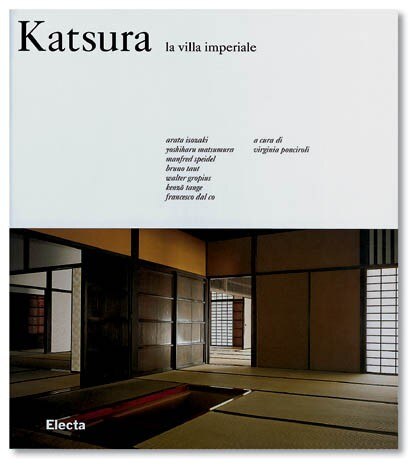Katsura la villa imperiale, A cura di Virginia Ponciroli Electa, Milano 2004 (pp. 400, € 110,00)
“Dear Corbu, all what we have been fighting for has its parallel in old Japanese culture. This rocky garden of Zen-monks in the 13 century – stones and racked white pebbles – would be by Arp or Brancusi – an elating spot of peace. You would be as excited as I am in this 2000-year-old spare of cultural wisdom! The Japanese house is the best and most modern I know of and truly prefabricated.” These were Walter Gropius’s words to Le Corbusier in June 1954. The naturalised American architect with German origins had embarked on a journey to Japan, during which he visited the imperial residence of Katsura in Kyoto.
The experience spurred him to write to Le Corbusier. A few lines summarising a consideration of the relations between Japanese historical culture and European modernity, appealing with surprising frequency to protagonists of the 20th-century avant-garde, even outside the architectural field. Le Corbusier visited the imperial residence the following year. With a sketch in his carnet (J37) of the modular plan of the tatami in the small room “à coucher du prince”, surprised by the rigour but also by the sobriety of the place, he noted: “la princesse est modeste”.
This observation is adopted for the title of the incisive piece of writing by Francesco Dal Co, who concludes this book with a look at the repercussions of Katsura’s long rolling wave on Western architectural culture. Bruno Taut was also deeply captivated by the imperial residence, as Manfred Speidel’s essay in the book retraces. This is followed by a re-proposal of certain texts by Taut accompanied by designs and notes that the German architect put in a small album in 1934 (Gedanken nach dem Besuch in Katsura). “The entire complex – writes Taut – from whatever side you looked at it, elastically followed the purpose that each of its parts, like the whole, was destined to perform, whether it be for normal daily use, representation purposes or expressing an elevated philosophical spirituality.
The wonderful thing was that these three purposes were so intimately connected together that the divisions between them could not be distinguished.” The web of relationships that Katsura represented went irrespectively beyond formal pregnancy to became the symbol of the metaphorical “chain” that Taut had already theorised in the manifesto Alpine Architektur (Hagen 1919). Katsura, and more generally Japanese culture, provided a confirmation to the ideas that Western architects and artists were developing at the beginning of the 20th century.
Moreover, the phenomenon of Japanism was already widespread in Europe and the United States by the end of the 19th century. For his The Bridge (1886), Vincent van Gogh drew on one of Ando Hiroshige’s most noted prints, while the group of so-called Boston Orientalists (among whom Edward Morse and Ernest Fenollosa) turned into veritable ambassadors and promoters of Japanese culture in the West. Artists quickly went from imitating traditional Nipponese forms to drawing ideas from it for a more profound theoretical consideration. The phenomenon also had a tangible influence on architecture, and another central figure in 20th-century architectural culture, Frank Lloyd Wright, nurtured a great interest in Japanese art. In 1905 the American architect went to Japan for the first time (where he would return many times, also staying for a long period between 1916 and 1922 during the construction of the Imperial Hotel).
Even though his itinerary took him to Kyoto, there is no mention of him visiting Katsura in the well-documented book edited by Melanie Birk, Frank Lloyd Wright’s Fifty Views of Japan. The 1905 Photo Album (San Francisco 1996). Nonetheless, as Kevin Nute demonstrates in his Frank Lloyd Wright and Japan (London 1993), Japanese culture had a large influence on Wright’s work, finding there (as would happen to Taut, Gropius and then Le Corbusier) the confirmation of an inquiry even though starting from a different context. An opening essay by Arata Isozaki demonstrates contemporary architects’ continuing interest in Katsura. As well as reconstructing the history of the imperial residence, built between 1617 and 1663, Isozaki illustrates the events and temporal spacing of the various pavilions’ construction.
He also discusses the paternity of the complex as it is now, traditionally attributed to Kobori Enshu (1579-1647), the garden architect and master of the tea ceremony from the early Edo period. But according to Isozaki, it is instead to be awarded to prince Yakahito (1703-1762), the seventh head of the Hachijo imperial family, who was directly engaged in the rearrangement of various parts of the palace. Isozaki’s piece of writing, which legitimises Katsura as an expression of the “Enshu style”, is well written and convincingly argued, but possibly reveals a lack of more specific documentary and bibliographic references, made all the more problematic by the obvious difficulties of translation from Japanese into Western languages.
The problem of translation is instead obviated for the recurrent expressions in this and other pieces of writing thanks to a glossary of names, places and terms transliterated from Japanese at the end of the book. The texts comprising the book are spaced by abundant graphic documentation of the surveys of the imperial residence’s buildings, initiated in 1982 and made available by the Imperial Household Agency in Tokyo. These are alternated with splendid colour images by Yoshiharu Matsumura, which aside from constructing an invaluable visual documentation for scholars, also make the book wholly enjoyable for less expert readers, revealing its accessibility to a wide audience.
Roberto Dulio Architect


